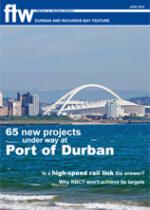The announcement earlier in
the year that the long-delayed
South Dunes Coal Terminal
(SDCT) had found “common
ground” with Richards Bay Coal
Terminal (RBCT) on the issue of
SDCT becoming an exporter of coal
in its own right, was a welcome
development after years of indecision
and stalling.
SDCT represents a consortium
of emerging coal miners anxious
to gain access to global export
markets – something that has been
stymied in the past by objections
from RBCT foot-dragging by
Transnet. Originally conceived as
a terminal in its own right on land
within the Port of Richards Bay that
that would have given it the right to
develop as a separate export terminal,
SDCT is now the largest component
of RBCT’s R1.2 billion Phase V
expansion project, with an allocation
of 6 million tonnes a year.
All of the Phase V capacity has
been allocated to new empowered
entrants, increasing RBCT’s annual
export capacity from 71mt to
91mt annually.
The increased capacity is timeous
and necessary, even though many
logistical problems remain to
be solved. India has become an
increasingly interested net importer
of coal from South Africa, and China
is showing strong interest. South
African coal exporters previously
relied mainly on European and
Turkish markets.
“We are delighted to welcome
SDCT as a valued coal exporter from
RBCT,” said RBCT chief executive
Raymond Chirwa, who added that
South Dunes would provide that
much needed additional tonnage in reaching RBCT’s target of 91mt
a year.
How well the terminal needs export
input from South Dunes and other
shareholders is patently clear. Last
year RBCT exported a mere 61.14mt,
a far cry from the heady days of
69mt and optimistic targets of 72mt.
A succession of problems, including
mammoth derailments along the
Richards Bay coal line, as well as
problems at the mine face where
exporters simply didn’t produce
sufficient coal to enable the port to
reach its targets, has retarded progress
at RBCT.
Maria Ramos, in her time as head
of Transnet, was quoted as saying
that on occasion when Transnet
trains arrived at the mines to collect
coal, there was none available. In
May 2007 she said Spoornet, as it
was then called, was being forced to
redirect trains from the coal line to
other businesses because there was
no product to rail. More recently Tau
Morwe, former CEO of Transnet
Port Terminals and now acting
CEO of Transnet Freight Rail, the
man who has the challenging job of
putting things right with the railway,
told journalists that some of the
mines lacked the proper equipment
to connect with TFR’s block train
requirement.
But returning to SDCT, Trevor
McGiddy, its chief executive,
made it clear that neither party was
particularly happy with what he
described as a “compromise on the
part of both parties”. No doubt part
of that unhappiness is that SDCT
has become a junior partner in the
RBCT consortium, and holds a
limiting allocation of just 6mt a year.
Nevertheless, he said that SDCT
was satisfied that the agreement
reached was the best option from a
business perspective.
The result is the most practical
and realistic, said McGiddy. “The
shareholders of RBCT, including the
new entrants, can now concentrate
on working constructively with TFR
to increase the rail capacity to RBCT
and enable South African exporters,
especially the new empowered
exporters, to participate more fully in
the growing global coal market.’
Therein lies the real challenge
facing the new RBCT. In the
aftermath of the recent Transnet strike
Raymond Chirwa conceded that the
strike had ensured that RBCT would
not reach its target of 65mt this year.
He said that on average RBCT
received between 1.3 and 1.4mt of
coal each week, which meant RBCT
had probably lost about 4mt during
the 18 days of no rail activity. “It
would be very difficult to catch up for
the year,” he said.
Rail cripples Richards Bay coal exports
09 Jul 2010 - by Terry Hutson
0 Comments
Durban 2010

09 Jul 2010
09 Jul 2010
09 Jul 2010
09 Jul 2010
09 Jul 2010
09 Jul 2010
09 Jul 2010
09 Jul 2010
09 Jul 2010
09 Jul 2010
Border Beat
Featured Jobs
New
New
New
